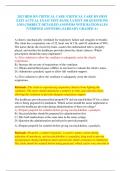Exam (elaborations)
2023 HESI RN CRITICAL CARE /CRITICAL CARE RN HESI EXIT ACTUAL EXAM TEST BANK LATEST 350 QUESTIONS AND CORRECT DETAILED ANSWERS WITH RATIONALES (VERIFIED ANSWERS) |ALREADY GRADED A+
- Course
- Institution
2023 HESI RN CRITICAL CARE /CRITICAL CARE RN HESI EXIT ACTUAL EXAM TEST BANK LATEST 350 QUESTIONS AND CORRECT DETAILED ANSWERS WITH RATIONALES (VERIFIED ANSWERS) |ALREADY GRADED A+
[Show more]



